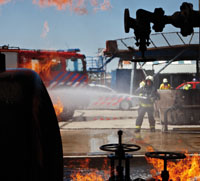|
Many radio users face the hazards of potentially explosive atmospheres in their working environments. But with radio equipment certified as intrinsically safe, they can communicate without creating accidental ignition. Tim Guest looks into ATEX equipment First responders in fire and rescue services, as well as private business users adopting TETRA solutions for their operations – in offshore/onshore oil and gas, petrochemical, food processing and other activities – may find themselves frequently confronted by potentially explosive atmospheres in their workplace. These may be due to the presence of flammable gases, mists, vapours or combustible dusts. When air is mixed with these in the right proportions, all that’s needed to create an explosion is an ignition source. Such a scenario might easily exist in the petrochemical industry, or where there are fine organic dusts such as grain flour or wood, as well as in activities such as paint spraying at a local vehicle body repair shop. Reducing the risk of an explosion in such an environment is best done by preventing dangerous substance release in the first place, or eliminating the chance of an ignition source being added to the mix. Part of that process is ensuring that correct equipment is used wherever and whenever possible, and while ATEX requirements cover all industry sectors, equipment makers, etc, in the case of TETRA end users that means operating handsets which meet ATEX standards. Regulations, directivesMany countries have national law governing hazardous working environments. In the UK, for example, a duty of care is placed upon employers to eliminate or control explosive atmospheres in the workplace by the ‘Dangerous Substances and Explosive Atmospheres Regulations 2002’ (DSEAR). These define an explosive atmosphere as a mixture of dangerous substances with air, under atmospheric conditions (20°C to 40°C and 0.8 to 1.1 bar of pressure), in the form of gases, vapours, mist or dust in which, when ignition occurs, combustion spreads rapidly to the entire unburned mixture. These regulations place the onus on any organization whose staff may face such a scenario to ensure that they are appropriately equipped. In the European Union, two crucial European Directives, known as ATEX (‘EXplosive ATmospheres’) directives, are aimed at regulating the control of those explosive atmospheres: Directive 99/92/EC (also known as ‘ATEX 137’ or the ‘ATEX Workplace Directive’) relating to minimum requirements for ensuring the health and safety of workers at risk from explosive atmospheres, and Directive 94/9/EC (also known as ‘ATEX 95’ or ‘the ATEX Equipment Directive’) concerning electrical equipment and protective systems intended for use in potentially explosive atmospheres. These help identify areas where explosive atmospheres might exist, enabling employers or organizations to classify them into zones based on size, location, and likelihood of an explosive atmosphere occurring in that zone. Such a zone might be physically marked on site with ‘EX’ signage. Individual devices such as radios are marked with codes indicating the zones or hazards they are certified for. This is where several of today’s TETRA handset manufacturers have stepped in to address the needs of those TETRA community radio users who face such hazards in their work. Designed to meet essential health and safety requirements, these handsets undergo strict conformity procedures often involving third-party testing and certification, in turn leading to the equipment being classified with the letters ‘EX’. At the current time, the manufacture of Intrinsically Safe (IS) TETRA handsets seems to be the preserve of just a handful of players, with Cassidian, Motorola, and Sepura taking centre stage while the less widely known Funkwerk also plays a part. The makers, the handsetsLaunched in 2011, Sepura’s STP8X extended the company’s reach into hazardous gases and dusty environments, where Intrinsically Safe ATEX/IECEx certified devices are an essential requirement. Mark Barnby, product manager, said that the STP8X meets the most recent updates of the ATEX and IECEx standards. At the launch of this product, he emphasized that the company had paid attention to how real users around the world operated their Intrinsically-Safe radios and accessories in a wide variety of market segments. “Loud, clear audio, the ability to use the radio whilst wearing bulky gloves and a new level of ruggedness were all key attributes that were not yet present in the market”, he said. He added that the STP8X embodied all of these requirements, and described it also as the first IP67-rated submersible TETRA Intrinsically-Safe hands-free radio.
|

